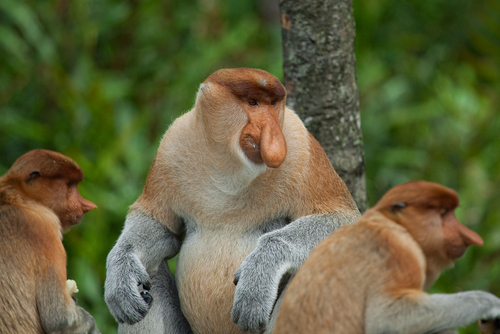
Proboscis Monkey
The proboscis monkey (Nasalis larvatus), with its iconic bulbous nose, thrives in Borneo's lush mangroves. Notable for its swimming prowess and vibrant social interactions, this arboreal primate plays a vital role in its ecosystem, aiding in seed dispersal and forest health.
15-20 years
Lifespan
45495.0 kg
Weight
Height: 53 - 76 cm
Size
Brown, Grey, Red, White, Tan, Orange
Color
4-5 years
Age of Sexual Maturity
7 months
Age of Weaning
15 mph
Top Speed
Endangered
Conservation Status
Decreasing
Population Trend
Characteristics
Nasalis larvatus, commonly known as the proboscis monkey, is distinctive for its large, pendulous nose. Endemic to the mangrove forests of Borneo, this arboreal primate is known for its excellent swimming abilities and social group dynamics. Males are larger than females, showcasing sexual dimorphism.
Distribution Range of the Proboscis Monkey
Nasalis larvatus, commonly known as the proboscis monkey, is native to the island of Borneo, which is divided among three countries: Malaysia, Indonesia, and Brunei. The species is primarily found in the coastal lowlands of Borneo.
Proboscis Monkey's Habitat
Environmental Conditions
Proboscis monkeys inhabit mangrove forests, swamps, and riverine forests. They are typically found in areas where freshwater and saltwater ecosystems meet, such as riverine and coastal mangroves. These environments provide the necessary food resources and are integral to their lifestyle.
Ecological Niche
Proboscis monkeys are highly adapted to arboreal life, spending most of their time in trees. They feed mainly on leaves, seeds, and fruits, showing a preference for young leaves and unripe fruits. Their digestive system is specialized to break down cellulose, allowing them to thrive on a diet largely composed of leaves. The proboscis monkey's ecological role includes seed dispersal and contributing to the health of their forest habitats.
Copyright @ Nature Style Limited. All Rights Reserved.
 English
English